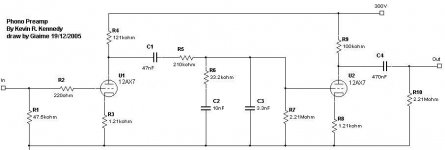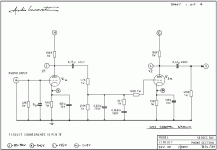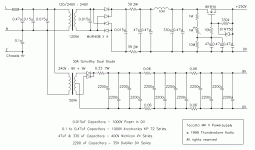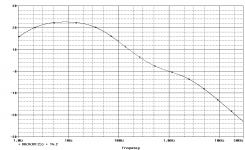kevinkr said:
If you are still looking for a simple phono stage I have an old set of designs using ECC83/12AX7A here: http://www.kta-hifi.net/projects/pre_page/ots_preamp/ots11.html
Thank you so much. I took a look at the Thoersten Loech phono pre discussion in this forum, I found it a little bit useless for my interests. Also, see one of my last posts (before the ones on the B+ regulator): I have been told from very competent people that the schematic posted there is completely inaccurate, with low gain and distant response from the real RIAA.
I will take a look at yours... 😉
Still thanks to anyone.
SY: a note about ECC88. In Europe it's not so common, at least here in Italy. This tube pretty much arrived with the new hi-fi trend to use it, for instance Audio Research preamps. All the vintage electronic junk that I've came across use limited types of tubes, and for the use of the ECC88, they like to use another ECC type instead.
Of course highly regarded NOS ones do exist, but they're high priced.
Giaime,
Send me your address in an email... be very carefull (detail), so I know how to copy/use it exactly.
There are "tesla" ECC88's on ebay in Bulgaria... across the water a small distance.
I am waiting for response from seller... if all is well, I will have them shipped to you.
Send me your address in an email... be very carefull (detail), so I know how to copy/use it exactly.
There are "tesla" ECC88's on ebay in Bulgaria... across the water a small distance.
I am waiting for response from seller... if all is well, I will have them shipped to you.
Returning on the "phono" question...
...ok, I've drawn the Simple One Tube Phono Pre by Kevin, aka kevinkr.
Any guru's comment on it? 😀
To adapt it to my 220V B+ I guess I've got to draw the Q points of the two stages (which luckily seem to be the same), and tweak the plate / cathode resistor to get the same gain and the same Vg-k...
And another question: those strange resistor values are those 1% metal ones? Because they aren't standard...
...ok, I've drawn the Simple One Tube Phono Pre by Kevin, aka kevinkr.
Any guru's comment on it? 😀
To adapt it to my 220V B+ I guess I've got to draw the Q points of the two stages (which luckily seem to be the same), and tweak the plate / cathode resistor to get the same gain and the same Vg-k...
And another question: those strange resistor values are those 1% metal ones? Because they aren't standard...
Attachments
Adding my 2 cents here.....
Regarding your tube failures....
DO you have a B+ delay???
I would recomend the heaters come on first prior to the B+...
I have seen a few pre-amp circuits eat up tubes due to this issue...
Chris
Regarding your tube failures....
DO you have a B+ delay???
I would recomend the heaters come on first prior to the B+...
I have seen a few pre-amp circuits eat up tubes due to this issue...
Chris
Hi Chris,
no, I don't have a B+ relay. Can you show me a simple way to implement a time delay to power up the relay coil? I was planning to switch the mains to the hi-volt PT instead of switching the B+ (because normal relays aren't rated for that), since my hi-volt PT is phisically separated from the filament one.
So, you have a regulated 12.6 volt and you have to make a 15second delay circuit to power up a relay. How would you do it? 😉
Aside from that, the noise now has totally disappeared (since I built the B+ regulator), but I'd like to know what was the cause before. Too high B+ (320V) maybe?
no, I don't have a B+ relay. Can you show me a simple way to implement a time delay to power up the relay coil? I was planning to switch the mains to the hi-volt PT instead of switching the B+ (because normal relays aren't rated for that), since my hi-volt PT is phisically separated from the filament one.
So, you have a regulated 12.6 volt and you have to make a 15second delay circuit to power up a relay. How would you do it? 😉
Aside from that, the noise now has totally disappeared (since I built the B+ regulator), but I'd like to know what was the cause before. Too high B+ (320V) maybe?
Giaime,
There is a capacitor (small) "hiding" between the PRI & SEC of your heater tranformer. There is another capacitor between the heater filament and the cathode. If your heater circuit is "floating" these capacitors carry signal into audio. When you ground or "anchor" the heater supply, the energy from the transformer cap is shorted to "AC ground" and the coupling is broken.
I guess (don't know for sure) this situation may become worse when you have asymmetry from rectification and filtering of the heater AC... have to think about that one!
Also, Santa Claus was once a poor student in engineering school eating pasta and potatoes. Things are different now... Santa Sent you 2 ECC88's. They should come from Bulgaria in one week. Santa used Ebay... look like used tubes but seller has 100% feedback. See your email!
Merry Christmas
There is a capacitor (small) "hiding" between the PRI & SEC of your heater tranformer. There is another capacitor between the heater filament and the cathode. If your heater circuit is "floating" these capacitors carry signal into audio. When you ground or "anchor" the heater supply, the energy from the transformer cap is shorted to "AC ground" and the coupling is broken.
I guess (don't know for sure) this situation may become worse when you have asymmetry from rectification and filtering of the heater AC... have to think about that one!
Also, Santa Claus was once a poor student in engineering school eating pasta and potatoes. Things are different now... Santa Sent you 2 ECC88's. They should come from Bulgaria in one week. Santa used Ebay... look like used tubes but seller has 100% feedback. See your email!
Merry Christmas
poobah said:Giaime,
There is a capacitor (small) "hiding" between the PRI & SEC of your heater tranformer. There is another capacitor between the heater filament and the cathode. If your heater circuit is "floating" these capacitors carry signal into audio. When you ground or "anchor" the heater supply, the energy from the transformer cap is shorted to "AC ground" and the coupling is broken.
I guess (don't know for sure) this situation may become worse when you have asymmetry from rectification and filtering of the heater AC... have to think about that one!
Yes, I think so. I've just remembered (re-reading the articles on my own site
 ) that the cracking/popping sound disappeared after I built the regulated heater supply: it stayed clean EVEN without referencing the heaters to ground, I mean with the heater supply totally floating.
) that the cracking/popping sound disappeared after I built the regulated heater supply: it stayed clean EVEN without referencing the heaters to ground, I mean with the heater supply totally floating. When I heated the filaments with AC, I tried everything: no ground reference, reference to the cathodes, reference to a clean voltage (resistor + cap from B+)... but nothing got ride of that nasty noise.
Oh however... now I'm happy 😀, my preamp is very quiet. The last remaining hum could only be due to lack of chassis, shielding etc etc... you know, building on a wooden board

poobah said:Also, Santa Claus was once a poor student in engineering school eating pasta and potatoes. Things are different now... Santa Sent you 2 ECC88's. They should come from Bulgaria in one week. Santa used Ebay... look like used tubes but seller has 100% feedback. See your email!
Merry Christmas
Thank you so much, and Merry Christmas to you and all of your family!!!
That's so exciting to be a member of diyaudio.com... 😀
Hi Giaime,
Where to "hunt"for old ECC88. Look in tuners of old television sets. It's normally a UHF tuner tube. Older repair men may have some too.
They ran them hot for high frequency use, so used ones may be "cooked". Some will be good still. They like higher currents and lower B+ voltages.
-Chris
Where to "hunt"for old ECC88. Look in tuners of old television sets. It's normally a UHF tuner tube. Older repair men may have some too.
They ran them hot for high frequency use, so used ones may be "cooked". Some will be good still. They like higher currents and lower B+ voltages.
-Chris
As I recall the tesla 12AX7A was quite good, used a lot of them as replacements and in some of my commercial product. Tesla became JJ around the time that Czechoslovakia ceased to exist as a country. IMHO the current JJ tube should be quite similar, but I have not compared old Tesla with new JJ to see how construction differed if at all.
One thing I seem to recollect is that the tesla 12AX7 seemed to have problems with cathode to filament insulation breakdown if the voltage difference exceeded about 60V.
Kevin
One thing I seem to recollect is that the tesla 12AX7 seemed to have problems with cathode to filament insulation breakdown if the voltage difference exceeded about 60V.
Kevin
poobah said:Here is nice circuit for delaying B+... uses sand parts.
I copied form another thread
Ehmmm... are you sure? That's quite unreadable! I have to stretch my eyes

anatech said:Hi Giaime,
Where to "hunt"for old ECC88. Look in tuners of old television sets. It's normally a UHF tuner tube. Older repair men may have some too.
They ran them hot for high frequency use, so used ones may be "cooked". Some will be good still. They like higher currents and lower B+ voltages.
-Chris
Thank you Chris for the information. In fact, I know a little place not far from here where they deal vintage electronics and TV sets, I'll take a look... One day the old repairman inside promised to give me an old tube tester to be restored, I'll have to remember him 😀
But as you see from one of poobah's last posts, I've quite solved my ECC88 problems 😉
Now I have a serious question. Attached this post there's the phono stage I'm building. It's from an Audio Innovations preamp, a trusty and tested design.
The questions are related to the grounding: I've never built a phono stage before, so please be patient 😉
1) I have a regulated B+. It's also powering the CF. Do I have to bypass the B+ locally in the phono stage with let's say 1K/33uF?
2) Where do I put the ground wire that comes with the turntable?
3) I want to run semi-balanced shielded wire to the input of the phono stage. They consist in wire with 2 conductors and a shield: one conductor takes the RCA hot, another one the RCA cold, and on only one side of the wire the shield connects to the RCA cold. But what side? The side on the input connector or the side near the tubes?
Other suggestions are welcome!
The filament regulator got very hot after adding another 2 tubes, I reduced the AC voltage before it to 12VAC (it was 15VAC before), so the LM317 has to drop less volts and stay cooler.
Thanks in advance to anyone will answer my questions.
The questions are related to the grounding: I've never built a phono stage before, so please be patient 😉
1) I have a regulated B+. It's also powering the CF. Do I have to bypass the B+ locally in the phono stage with let's say 1K/33uF?
2) Where do I put the ground wire that comes with the turntable?
3) I want to run semi-balanced shielded wire to the input of the phono stage. They consist in wire with 2 conductors and a shield: one conductor takes the RCA hot, another one the RCA cold, and on only one side of the wire the shield connects to the RCA cold. But what side? The side on the input connector or the side near the tubes?
Other suggestions are welcome!
The filament regulator got very hot after adding another 2 tubes, I reduced the AC voltage before it to 12VAC (it was 15VAC before), so the LM317 has to drop less volts and stay cooler.
Thanks in advance to anyone will answer my questions.
Attachments
Dear audiophile friends,
I've built the phono stage, and got success with the quiescent currents of the tubes, they are more or less those on the schematic on my last post. The question is always the same: grounding? please help me!
I've built the phono stage, and got success with the quiescent currents of the tubes, they are more or less those on the schematic on my last post. The question is always the same: grounding? please help me!
Hello!
I've tried the phono stage: you expect great detail, no noise, very dynamic sounding etc etc...
Nope: obviously no right channel output, big hum and weak signal, with a sensible cut on the bass frequencies. Could the RIAA network be wrong? I've rechecked it several times... also, please give me some tips on phono pre grounding.
I've tried the phono stage: you expect great detail, no noise, very dynamic sounding etc etc...

Nope: obviously no right channel output, big hum and weak signal, with a sensible cut on the bass frequencies. Could the RIAA network be wrong? I've rechecked it several times... also, please give me some tips on phono pre grounding.
Big hum- grounding. Maybe inductive pickup, too.
Lack of bass and weak output- what are you loading this with?
Lack of bass and weak output- what are you loading this with?
Sorry SY, don't mind my post. It was a stupid wiring error: I'm using old p2p turrets from an old amp: I connected a tube grid on a turret, and the ground on the adjacent turret, but I didn't see the thin wire connecting the two... 
So aside from this, I really have to try out the preamp. I'll do this tomorrow... now it's late. Thank you so much anyway.
Could you give me some advices on phono grounding instead? Do the phono "GND" wire has to go to the earth ground? Or to the cathode ground of the first tube?
Also if I have to connect the phono input rca jack to the tube, and I use shielded wire for each channel (2 conductor + shield), do I have to ground the shield at the connector or at the cathode ground node?
Thanks in advance!!!

So aside from this, I really have to try out the preamp. I'll do this tomorrow... now it's late. Thank you so much anyway.
Could you give me some advices on phono grounding instead? Do the phono "GND" wire has to go to the earth ground? Or to the cathode ground of the first tube?
Also if I have to connect the phono input rca jack to the tube, and I use shielded wire for each channel (2 conductor + shield), do I have to ground the shield at the connector or at the cathode ground node?
Thanks in advance!!!
Hi Giaime,
With such small signals, you want to connect each input ground to the cathode ground near the tube. Keep them separate. The thought is you are amplifying the difference between grid and cathode. You would rather not include common mode signals. (noise, hum)
Then ground the circuit as you normally would.
-Chris
With such small signals, you want to connect each input ground to the cathode ground near the tube. Keep them separate. The thought is you are amplifying the difference between grid and cathode. You would rather not include common mode signals. (noise, hum)
Then ground the circuit as you normally would.
-Chris
- Status
- Not open for further replies.
- Home
- Amplifiers
- Tubes / Valves
- Plate choke on a line stage?




